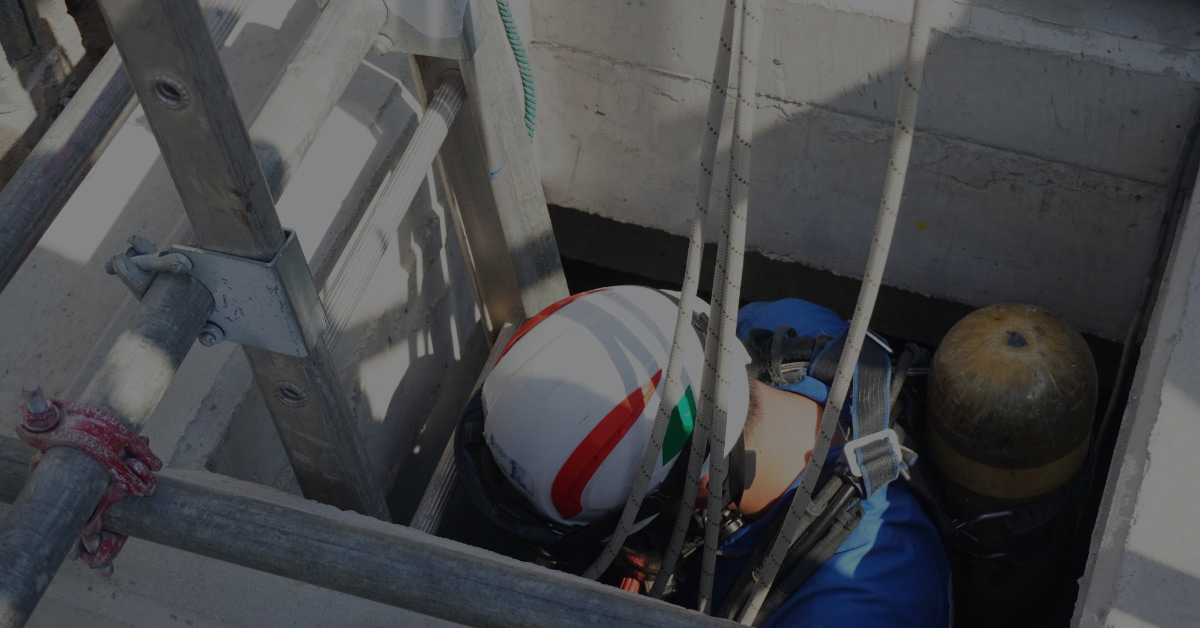What is a Confined Space Rescue Team?

When you hear "confined space," does it leave you with more questions than answers? First Choice Safety Solutions is here to clear up all of your questions, from "What is a Confined Space?" to "What are Common Types of Confined Space Teams?". In Part 2 of our three-part series of posts, we'll dive into what a confined space rescue team really is, when one is necessary, and some of the OSHA requirements related to them. If you missed Part 1, you can go back to find out more about "Creating A Confined Space Rescue Plan" or move ahead to Part 3 "Common Types of Confined Space Rescue Teams".
What Is a Confined Space Rescue Team?
A confined space rescue team comprises trained and equipped individuals performing rescues in confined spaces. Confined space rescue teams are trained in various techniques for rescuing individuals trapped, injured, or incapacitated in these spaces. They may use specialized equipment such as air monitoring devices, ventilation systems, and technical rescue equipment such as rope, pulley progress capture devices, haul systems, and specific rescue harnesses to perform these rescues safely and effectively.
A confined space rescue team can either be internal, meaning they are employed by the organization responsible for the confined space, or external, meaning they are a third-party organization.
OSHA's confined space standard does include some guidelines, including team evaluation in Appendix F to § 1910.146 - Rescue Team or Rescue Service Evaluation Criteria (Non-Mandatory).
When Is an Onsite Confined Space Rescue Team Necessary?
Many sections of the OSHA standard allude to the need for a rescue team. Still, the following is particularly blunt:
"OSHA believes that compliance with all the provisions of § 1910.146 will enable employers to conduct permit space operations without recourse to rescue services in nearly all cases. However, experience indicates that circumstances will arise where entrants must be rescued from permit spaces. It is therefore important for employers to select onsite or off-site rescue services or teams that are equipped and capable of minimizing harm to both entrants and rescuers if the need arises."
An onsite confined space rescue team is necessary when there is a potential for a worker to become trapped, injured, or incapacitated in a confined space. The decision to have an onsite rescue team should be determined by the results of a risk assessment, which considers the hazards associated with the confined space, the complexity of the rescue, and the response time of local emergency services.
In addition, factors such as the nature of the work being performed, the size and configuration of the space, and the number of workers involved should also influence the decision to have an onsite rescue team.
Despite these apparent dangers, many companies fall short of the proper precautions regarding confined spaces. As a result, according to the Bureau of Labor Statistics, 1,030 workers died in confined spaces between 2011 and 2018, an average of 129 fatalities per year, according to a 2020 report from the US.
Does OSHA Have Confined Space Team Requirements?
Yes, OSHA has specific requirements for confined space rescue teams in its Confined Spaces Standard (29 CFR 1910.146). The standard requires employers to evaluate the hazards of the confined space and determine if the rescue operation requires an onsite rescue team or if it can rely on local emergency services.
The team must be trained and equipped to perform rescue operations, and the employer must develop and implement procedures for the rescue team to follow in an emergency. In addition, OSHA requires that the rescue team be capable of responding to a rescue operation within a reasonable amount of time, which typically means no more than five minutes for IDLH (immediately dangerous to life and health) spaces and ten minutes for non-IDLH spaces.
The standard also requires the employer to ensure that the rescue team is provided with appropriate personal protective equipment (PPE) and rescue equipment, including respiratory protection, harnesses, hoists, and equipment training. Finally, the standard requires that the rescue team conduct practice rescues at least once yearly to ensure they are prepared to respond to an emergency.
29 CFR 1926 Subpart AA, which is OSHA's Standard for Confined Spaces in Construction, requires employers to assess the hazards in each confined space and ensure that their employees are adequately trained and equipped to respond to emergencies. Employers must also have a plan to respond to emergencies and ensure that all employees involved in a confined space rescue understand their roles and responsibilities.
How Many Rescuers Are Needed on a Rescue Team?
Determining the appropriate size of a confined space rescue team depends on several factors, including the size and complexity of the confined space; larger and more complex confined spaces may require a larger rescue team to perform rescue operations safely and effectively.
The type of work being performed in the confined space may also impact the size of the rescue team. For example, a larger rescue team may be necessary if the work involves hazardous materials or dangerous equipment.
Evaluate potential confined space hazards and ensure that the rescue team is adequately trained and equipped to handle those hazards. Depending on the hazards present, a larger or more specialized rescue team may be necessary.
As part of the employer's obligation to evaluate the prospective rescue team's capability, in accordance with Appendix F to § 29 CFR 1910.146 - Rescue Team or Rescue Service Evaluation Criteria (Non-Mandatory), the employer shall also evaluate the number of rescuers necessary.
29 CFR 1910.146 does not stipulate a specific number of personnel needed for stand-by operations. Instead, the team or service must complete the task safely and efficiently.
Section (d)(9) of the regulation mandates developing and implementing procedures for summoning rescue and emergency services, rescuing entrants from permit spaces, and providing necessary emergency services to rescued employees. However, the number of team members required is left to the discretion of the employer or agency.
Section (k) provides additional details on rescue and emergency services, but once again, no specified number of team members is required. The number of rescuers needed depends on the confined spaces to which they may respond and their ability to perform the necessary rescue operations.
According to Section (g)(3)(i) of the Respiratory Standard (29 CFR 1910.134), it is mandatory to have at least one employee situated outside the IDLH atmosphere. Additionally, Section (g)(3)(iii) specifies that the employee(s) located outside the IDLH atmosphere must be trained and equipped to deliver efficient emergency rescue; no specific number of personnel is mentioned.
While OSHA does not specify a minimum number of rescuers, The NFPA 1670 Standard on Operations and Training for Technical Search and Rescue Incidents (NFPA 1670) 7.3.2.1 states the following:
In general, confined space rescue teams are composed of no less than six members to perform all the required functions listed. However, the size and capability of a team required to perform a specific rescue will depend on many factors, including the condition of the patient, the size and shape of the space, size of the access opening, and the hazards present. The positions described in 7.3.2.1(1) through 7.3.2.1(4) describe the minimum number of exclusive roles that must be filled to perform an entry-type rescue. Many rescues will require additional functions such as ventilation, rope rescue support, or communication that will require additional trained resources. Pre-incident planning of representative spaces is a key element in determining the size and capabilities of the team.
Chapter 7, Section 7.3.2.1 states:
The role of a confined space rescue service is intended to include entry into the space to perform a rescue and, as a minimum, shall be staffed to provide sufficient members with the following exclusive functions:
(1) Rescue entrant / entry team of sufficient size and capability to perform the rescue
(2) Backup rescue entrants of a sufficient number to provide immediate assistance to, or rescue of, rescue entrants who become ill or injured and are unable to perform self-rescue
(3) Rescue attendant whose function is to deny unauthorized persons access and to monitor the conditions in the space and the status of all entrants
(4) Rescue team leader (supervisor) whose function is to maintain control of the entire operation and be knowledgeable in all rescue service functions
As you can see, the standard suggests that confined space rescue teams should have at least six team members to perform all the required functions. Team functions should be used to assess the minimum number of rescuers needed and evaluate the team's capability, patient condition, size and shape of the space, and hazards present. In an emergency, the host site may supplement some rescue team's roles to free up rescuers, such as the attendant role, which could be a trained attendant (non-rescuer).
Respond in a Timely Manner
The OSHA Confined Spaces Standard (29 CFR 1910.146) requires that the employer "provide a rescue service that is capable of responding in a timely manner." The specific time requirements are outlined in the following section:
1910.146(k)(1)(i)
Evaluate a prospective rescuer's ability to respond to a rescue summons in a timely manner, considering the hazard(s) identified;
Note to paragraph (k)(1)(i): What will be considered timely will vary according to the specific hazards involved in each entry. For example, § 1910.134, Respiratory Protection, requires that employers provide a standby person or persons capable of immediate action to rescue employee(s) wearing respiratory protection while in work areas defined as IDLH atmospheres.
1910.146(k)(1)(ii)
Evaluate a prospective rescue service's ability, in terms of proficiency with rescue-related tasks and equipment, to function appropriately while rescuing entrants from the particular permit space or types of permit spaces identified;
1910.146(k)(1)(iii)
Select a rescue team or service from those evaluated that:
1910.146(k)(1)(iii)(A)
Has the capability to reach the victim(s) within a time frame that is appropriate for the permit space hazard(s) identified;
1910.146(k)(1)(iii)(B)
Is equipped for and proficient in performing the needed rescue services;
1910.146(k)(1)(iv)
Inform each rescue team or service of the hazards they may confront when called on to perform rescue at the site; and
1910.146(k)(1)(v)
Provide the rescue team or service selected with access to all permit spaces from which rescue may be necessary so that the rescue service can develop appropriate rescue plans and practice rescue operations.
Note to paragraph (k)(1): Non-mandatory appendix F contains examples of criteria that employers can use in evaluating prospective rescuers as required by paragraph (k)(1) of this Section.
OSHA's guidance on response times for rescue operations in confined spaces states that the time required for rescuers to reach entrants and begin rescue operations depends on the specific hazards and conditions present in the confined space. OSHA does not specify a specific time limit for rescue operations, but employers must ensure that rescue services are capable of responding to an emergency in a timely manner, taking into account the particular hazards of the confined space. Generally, IDLH rescue operations should be completed within a few minutes, and non-IDLH rescues should be completed within 10 minutes or less. It is important for employers to develop effective rescue plans and provide appropriate rescue equipment to minimize the time required for rescue operations.
It is important to note that these response times are not absolute, and the specific circumstances of a rescue operation may require a different response time. Employers should assess the hazards of their confined spaces and the capabilities of their rescue teams when developing their rescue plans and determining response times.
While response times are an important factor to consider when selecting a confined space rescue team, they are not the only assessment that should be made. Other important considerations include the team's level of training, experience, equipment, and ability to assess and manage the risks associated with confined space rescue operations. The teams should be well-versed in current industry best practices and relevant safety standards and regulations.
Ready to learn more?
This post is Part 2 in a three-part series. Check out all three topics:
Part 1: "Creating A Confined Space Rescue Plan"
Part 2: "What Is A Confined Rescue Team?"
Part 3: "Common Types of Confined Space Rescue Teams"











